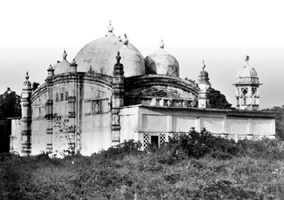Sarail Hatkhola Mosque
Sarail Hatkhola Mosque is located in the heart of Sarail thana Bazar, about 11.5 km due north of Brahmanbaria district headquarters. Although now in a good state of preservation, the mosque has suffered much due to unplanned restoration and repairs done by the people of the locality. The original building can now be viewed only from its rear because of the recent addition of a flat masonry veranda on the north, east and south sides. The mosque still bears an inscription recording its erection by the wife of Nur Muhammad, son of Majlis Shahbaz, during the reign of aurangzeb in 1670 AD.

Built entirely of brick, the mosque is oblong in plan (14.02m x 7.62m). It has four octagonal towers at its four exterior angles, which extend much beyond the roof, and are capped with kalasa finials. The parapets and the two cornice bands are beautifully curved in the sultanate building style.
Access to the mosque is provided through arched doorways – three in the east and one on each of the north and south walls. The eastern doorways have front and rear arches with vaulted spaces in between. The central archway is projected slightly and has bordering ornamental turrets, although those have now been badly damaged. Inside, the western wall accommodates three semi-octagonal mihrabs in the axis of the three eastern doorways. The central mihrab shows an outward rectangular projection with semi-octagonal flanking turrets which rise above the roof and terminate in ribbed cupolas with kalasa finials.
Two east-west wide arches springing from engaged brick pillars divide the interior of the mosque into three bays ' the central one square (4.75m a side) and the flanking ones rectangular (4.75m x 1.98m). A big dome on a circular drum covers the central bay.
This is directly carried on two east-west wide arches, including the blocked arches over the central archway and the central mihrab and the traditional Mughal pendentives on the four upper angles inside the building. Each of the side rectangular bays is covered by a vault, which is internally of the chau-chala type, but over it on the exterior side are two small false domes. The mosque therefore has five domes over the roof ' a large central dome and four small ones on its four corners. All these domes are now crowned with kalasa finials.
The ornamentation of the building consists of panels and terracotta decorations. The exterior wall surface is variegated with rows of sunken panels, the upper rows being marked by blind arched motifs. The terracotta decoration is confined to the central archway, the central mihrab, and the corner towers. The rectangular frame, within which the central archway is set, is adorned with scrolls, rosettes, jali work and interlocking patterns. The spandrels of the doorway arches are embellished with boldly executed floral scrolls. The central mihrab, screened off by a multi-cusped arch, is also contained within a rectangular frame decorated with spiral-floral scrolls, rosettes and network designs. The mihrab arch springs from decorated engaged pillars, which are divided by moulded bands at intervals. The interior of the mihrab niche is divided into sections by slightly raised bands. The spaces in between these bands are filled with vertically placed small rectangular panels, each ornamented with a cusped arch design having a chain and bell motif hanging down from its apex. The bands are depicted with dogtooth designs. Above and underneath the moulded bands, which divide the corner towers into sections, are rows of upright and inverted petals. Although at present they are smoothly plastered over, the spaces in between these bands of corner towers must have been originally enriched with terracotta decorations, traces of which still survive on the south-western corner tower.
Roofed over by a large central dome with flanking small domes on the four corners, the Sarail Hatkhola Mosque represents a distinctive type of Mughal mosques in Bengal. Such a mosque style first made its appearance in Bengal in Qutb Shah's austagram mosque in Kishoreganj, dated approximately in the late 16th century, when the area was still outside the control of the Mughals. It is from this Ashtagram example that the ground plan and roofing system of the present Mughal mosque at Sarail, which is only fifteen miles away, must have been directly inspired. And the idea of such a distinctively Bengal mosque must have been imported from such other examples outside the country as the Jamat Khan mosque (1310-16) at the dargah of Nizamuddin Auliya at Delhi and Sher Shah's mosque (c 1540) at Patna in Bihar. Two more examples of the type in a much more developed form have hitherto been discovered ' the walipur alamgiri mosque (1692) in Comilla and the Becharam Deuri Mosque (1872) in old Dhaka.
An important aspect of the Sarail mosque is that it provides, like many others in the country, example of a happy blending of two different art traditions ' the Sultanate style and the Mughal style. The former is best represented by bent cornices and terracotta ornamentation, while the latter is represented by the use of panels on the exterior surface of walls and the surface plastering, the use of drum under the domes, and the extension of the corner towers much beyond the parapet. [MA Bari]
